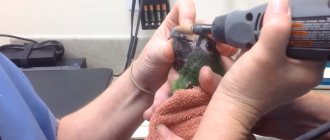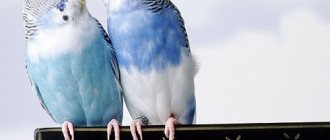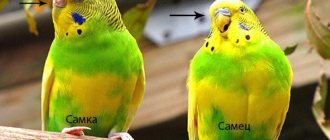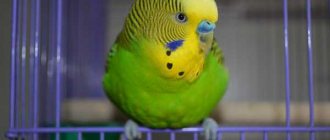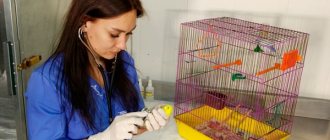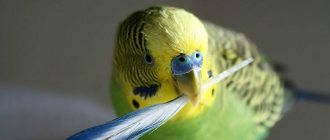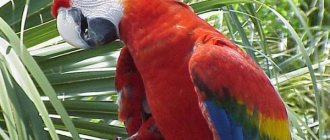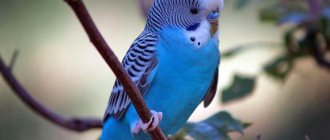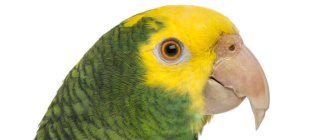Will a parrot's tail grow back if it is torn off?
Parrots often suffer from their curiosity. This can lead to the loss of tail feathers. Will a parrot's tail grow back if it is accidentally torn off by children or pets? Of course, the answer is yes.
Reasons for loss
Typically, a bird loses its plumage in two cases:
Reasons why a parrot loses tail feathers
- Seasonal molting is a natural process. If the pet behaves normally, the owner does not need to worry.
- Improper nutrition leads to weakening of feathers. They become loose and weak. They don't hold well and fall out. In this case, you need to think about proper nutrition for your feathered pet.
There are other, less common problems of tail feather loss:
- stress;
- parasites;
- disruption of the coccygeal gland.
Checking your parrot for parasites or mites
To more accurately determine the cause, you can conduct a test for the presence of fluff eaters. Place a white sheet of paper on the bottom of the cage overnight, after smearing the edges with Vaseline or greasy cream.
In the morning, check for small crawling ticks. Pay attention to the fallen feathers. If you notice black or brown spots on the lower part of the rod, then the reason is parasites.
First aid for a bird
Many owners of feathered pets, and especially beginners, are often lost and do not know what to do when they notice the first loss of feathers in their parrots. However, in this case, you should not be alarmed - it is recommended to make an appointment with a veterinarian as soon as possible, who can accurately determine the cause, as well as prescribe the correct treatment.
At home, when self-plucking, you first need to treat the tail with a bitter spray (for example, Beafar Spray) or a soda solution, which can discourage the desire to pull out feathers.
You can also use a special collar, which can temporarily protect feathers and skin from additional beak injuries. The drug “Aloe Vera” is well suited for treating the skin, which is an antiseptic and hemostatic agent, while simultaneously softening and moisturizing irritated skin.
In case of injuries, they should be treated with hydrogen peroxide or a solution of Eplan, Ditsinon, or Etamzilat. After the bleeding has been stopped, the wound needs additional disinfection - Betadine, Chlorhexidine, Miramistin are well suited for these purposes. At the same time, you should absolutely not use alcohol, iodine or brilliant green.
Did you know? Parrots can be right-handed or left-handed
—
In order to determine this, you just have to take a closer look at which paw the bird most often uses to take food or open the cage door.
What could be the consequences?
Why does a bird need a tail? It acts as a rudder during flight. With a slight change in the position of the tail, the flight path changes. Until the plucked feathers grow back, your pet may have trouble flying. During sleep, he will fall from the perch. These are simple problems and in a couple of months the parrot will be as good as new.
The situation is much worse if the plumage is lost as a result of vitamin deficiency or some other disease. In this case, contact a specialist. The veterinarian will make a diagnosis and prescribe the necessary treatment.
If the feathers on the tail are torn out, wounds and blood are visible, first of all treat the wounded area with one of the following medications:
- Miramistin (chlordixedine). The drug does not leave burns, unlike hydrogen peroxide. In addition, it fights a number of microbes that cause suppuration, sore throats, and fungal pathologies.
- Betadine. This is an analogue of iodine from 0.1% to 1%. A complex antiseptic drug containing iodine and polyvinylpyrrolidone. The spectrum of activity is quite wide: fungi, bacteria, viruses, microflora.
- Furacillin is an antibacterial agent. Used for the prevention and treatment of purulent-inflammatory diseases. Prepare a solution: 1 tablet per 200 ml of water. Wash the wounds to prevent suppuration. In such processes, it helps clear the infection.
- Eplan. It is used to disinfect wounds. Antiseptic.
- Dicynone. Hemostatic drug.
Important! After handling the bird, be sure to wash your hands with soap. Some parrot diseases are dangerous to human health and life.
The owner needs to know about proper care for his feathered friend for his good health and mood. In the wild, birds eat grains, greens, vegetables, and fruits. In the same way, you need to diversify the diet in the cage. Change water and food daily. Place chalk and sand in the house.
Atheroma
The origin of atheroma is fundamentally different from lipomas. Atheroma develops from the sebaceous glands of the skin. For various reasons, the gland duct becomes clogged, secretion accumulates in the gland, which gradually begins to increase in size. Atheroma is defined as a small (from 0.5 to 2 - 3 cm) formation, which always rises somewhat above the skin and is always fused to it (i.e. the skin above the atheroma does not move), and can grow slowly. Atheroma always has a capsule and contains atheromatous masses resembling crushed lard.
Because The atheroma is connected to the external environment by a duct; there is always a threat that it will become infected through the duct and suppuration will occur. In this situation, moderate pain appears in the area of the previously “quiet” atheroma, the formation quickly (over several days) increases in size, redness appears around it, and body temperature may rise. Suppuration of atheroma requires urgent surgery.
Will the tail grow back?
Your favorite feathered friend's tail will definitely recover. Try to protect it from an aggressive environment. Do not let him out of the cage in front of guests, do not allow him to frighten or catch the bird in flight. And then the tail will remain in place and you won’t have to worry about it being pulled out and whether it will grow back.
Love your pets, be attentive and caring. Create a comfortable environment for them. Parrots will delight you for many years. Good luck!
Your rating is very important to me
Rate the article from 1 to 5
Average rating 5/5. Total ratings 14
There are no votes yet - be the first to rate!
Ripper parrot: wallpaper, wires, flowers...
Hello, Mitya! I assume that we are talking about a female parrot. It is these birds that tend to cause “havoc” in the apartment during a walk: gnawing wallpaper, chewing wires, feasting on indoor flowers. There may be several reasons for this behavior. Below we will look at the situation in more detail.
Cosmetic procedures: beak grinding
Since the claws and beak are constantly growing, the parrot tends to regularly engage in “cosmetic care”. A beak that is too long is inconvenient to “use” – when feeding, caring for feathers, etc. If there are no suitable “tools” in the cage, get ready, the wallpaper and furniture will suffer. And in general, everything that a pet can chew or pick apart will be destroyed.
As a rule, in this case the parrot does not eat the “prey”, but chews it and scatters it around the apartment. Preventive measures are to place mineral stones and sepia in the cage. It is also useful to provide the bird with access to hard toys, dry crackers, all kinds of perches, twigs and sticks.
Boredom is the driver of parrot activity
A parrot living alone is most likely to suffer from boredom. If there are no exciting activities for him in the cage or in the room, he will try to find entertainment to his liking. Driven by the instinct to grind down its beak, the pet quickly discovers that crumbling wallpaper or other fragile materials is a very exciting activity.
It is necessary to offer the bird something in return - something that will captivate him and will like him. For this purpose, parrot owners equip play stands, place toys in “strategic places” and... think about purchasing a second parrot. Another working method is to offer your pet a simple piece of paper and allow it to be “destroyed.”
The luxury of communication
They say that parrots are one of the most highly developed living creatures on the planet. The smarter the animal, the more it needs communication and communication. In captivity, a parrot's "flock" is the human family among which it lives. If the bird lacks attention, the easiest way to attract it is to do something illegal. After all, she knows: if you go to the wallpaper, the person will drop everything, start waving his arms and shouting. And all for her sake, dear.
What to do? A person will have to change his behavior:
- First, analyze whether you are paying enough attention to your pet? Do you spend a lot of time with him? Are you talking to him? Do you express positive emotions and joy from communication? And make adjustments.
- And, secondly, distract the parrot from unwanted actions. One of the easiest ways is to attach an object that frightens him near the area he is chewing. Usually a toy or fan, New Year's tinsel, etc. are used in this capacity. First you need to “attack” with a toy so that the object causes fear. And then use it for its intended purpose.
- If for some reason the “scarecrow” option is not possible, develop a ban command. This could be, for example, the word “ugh!” or cotton. The procedure is as follows. If you notice that the child is doing something unwanted, clearly say the command or clap your hands, then drive him away from the scene of the “crime” with a rolled-up newspaper. Do not use your hands for this so that he does not perceive them as a source of threat.
How to determine the age of a budgie
The information contained in this article should be known to everyone who is planning to buy this wonderful bird. You may be thinking, “What is this for?” The fact is that there are often cases when sellers try to sell old, sick birds to buyers. If you know how to independently determine the age of a budgie, then you will not be deceived and will be able to buy a young parrot. I’ll warn you right away that the older the bird, the more difficult to understand how many months or years old it is. Well, let's start looking at the main ways to find out age.
The most common ways to determine the age of a budgie
As a rule, a potential buyer wants to buy a young pet. In fact, this is a completely reasonable desire, since small parrots learn to speak more easily, adapt to new living conditions more quickly, and live longer than adults.
It is not recommended to purchase parrots from a pet store that are already quite many years old. The thing is that in stores, birds are usually not looked after as they should be. They are fed low-quality, cheap food there. In areas where parrots are kept, there is insufficient lighting. As a rule, pet stores do not allow birds to fly freely. As a result, such living conditions negatively affect the health of parrots. Therefore, you need to buy adult birds only from breeders who have managed to prove themselves well.
The maximum that these winged pets can live is 15 years. They usually live less than 10 years. One year of life of a feathered friend corresponds to ten years of human life. It should be noted that specific data regarding the age of a budgerigar by human standards have not been established, that is, 1 in 10 is a rough guide. Of course, you want your pet to live as long as possible. Therefore, you need to buy a young parrot. Next, we will just talk about ways to determine age and learn to distinguish an old bird from a young individual.
Some exceptions
Difficulties may arise when determining the age of budgerigars of the albino and lutino varieties, since both adult and young representatives of these bird species have dark red irises and red eyes.
Males that belong to these breeds of parrots always have a pink-violet wax (sometimes a blue reflection). The same applies to pure budgerigars and other representatives of budgerigars with the “ino” mutation. However, in females of such species, the cere, as usual, begins to change color at five or six months. Thanks to this, it is possible to approximately determine the age of such female budgies and distinguish between young and adult birds.
The beak of parrots that have light-colored feathers or celandines may lose their black color, although the bird is not yet a month old. Most often, the black color on the beak of these representatives disappears on the twentieth or twenty-fifth day of the bird’s life, or it may not exist at all.
I hope that now you can independently determine the age of the bird by its appearance. If you have a parrot, how old is it? Please share this information with us and our readers in the comments.
Below I also post useful videos on the topic. Enjoy watching!
Symptoms
Identifying the problem in both cases is usually not difficult.
Signs of lipoma:
- mobile and painless, sizes can range from a few millimeters to 10-15 cm;
- to the touch - doughy or dense;
- not fused to the skin - the skin easily moves over the formation;
- never becomes inflamed – i.e. There is no redness or swelling of the skin above the lipoma.
Most often, lipomas are located on the limbs, head and torso; they are almost never on the face.
Children tore off cockatiel's tail
- Hello. We're in trouble! Children tore off the entire tail of a cockatiel chick. Is there a risk to his health? And will a new tail grow?
Marina Nesterova, Belgorod
The health damage comes from the stress your bird has endured. The tail will recover over time. The growth of new feathers depends on the state of the nervous system, on the functioning of the thyroid gland and other endocrine glands. Use special feed for feathering and enriched with iodine.
Signs of acidic and salty soil
Pilaf in Georgian style from the soloist of A-Studio
Appetizer "Crab bars"
What are the benefits of agave?
Chicken dishes
Reproduction by shoots
PEOPLE'S REPORTER
New from users
Natalya Tartanova: The berry business changed my life.
I am a native city dweller; I have lived in an apartment all my life. But, apparently, there is some kind of “earthyness” in my blood.
Russian stove with fireplace, or three in one
Over more than half a century of experience as a stove maker, I have had to make different versions of stove designs. In general, etc.
Symptoms of atheroma
The formation is in the form of a tubercle, painless, mobile, fused to the skin, you can often see the opening of the excretory duct of the gland. Most often, the “bump” is located on areas of the body where there is hair: on the face, scalp, in the genital area, on the legs, on the back, and is found on the face. If a suppurating atheroma appears, the formation increases in size over several days, the skin on the affected area may turn red and become painful, and the temperature may also rise.
Diseases of budgies
Diseases of budgies
If you have chosen a budgerigar as a pet, then you need to carefully monitor its nutrition and maintenance. Everyone knows that it is better to prevent a disease than to treat it later. Anyone, even a non-specialist, can distinguish a healthy parrot from a sick one.
If the parrot is completely healthy, then its feathers are clean, even, smooth, and its eyes are shiny and wide open. The parrot often tweets, plays, and reacts to others. A healthy bird sleeps with its head tucked under its wing and rests on one leg.
The sick bird is crested, sits only on two legs, and trembles. He does not bathe, does not clean himself, and practically does not react to his surroundings. With proper feeding and care, a budgie can live about 18 years. However, such situations are extremely rare. Most people do not notice the parrot's illness, and some people turn to a specialist for help already.
Signs of disease in budgies
Signs of disease in budgies
1. The budgie does not play, does not clean itself, and sleeps all the time. 2. A severely emaciated parrot has a protruding keel. 3. The bird sniffles and liquid discharge appears. 4. If a parrot sits on a perch with its tail lowered perpendicular to the floor, then it suffers from a pulmonary disease. 5. Thirst indicates problems with the kidneys and digestive organs. 6. There are wounds, redness, and growths on the paws. In this situation, we can talk about the presence of a bacterial infection.
Parrot diseases
Mites on budgies
The disease is caused by small mites that penetrate the parrot's skin and spread to the paws, in the eye area, around the beak and cere. This mite causes spongy growths to appear on the paws and head, causing severe itching. If the disease is not treated, the bird's beak becomes deformed. He has difficulty eating, which leads to death.
Downy parakeet in budgies
The disease often affects parrots kept in unsanitary conditions. If you often take a cage with a parrot out into the garden or onto the balcony, then you need to make sure that it cannot come into contact with other birds. You can see this parasite with the naked eye. When held up to light through a bird's feather, the feather will appear stitched. The parasite itself is a small worm that moves with the help of villi.
With this disease, the bird sleeps poorly, eats, itches, and shakes. The plumage becomes dull and ruffled. The feathers on the head and belly may disappear, and scabs may appear on the skin.
Inflammation of goiter in budgies
The disease can occur when feeding spoiled food, poisoning with plant poisons, inhaling chemicals, or pulmonary diseases.
A sick parrot often burps. This process becomes difficult for him. The bird practically does not eat, it looks lethargic. If you look at the bird from the side, you can see an increase in the crop. There may be a rotten smell coming from the beak. If the above symptoms occur, you should immediately contact a specialist. The sooner treatment is started, the better the disease responds.
Watch the educational video: Parrots, prevention of diseases from fluff eaters, fungi and mites
Comments
Pulling out feathers is a fairly common phenomenon, and various species of birds kept in captivity are susceptible to it, but especially parrots, and especially large ones.
Reasons for birds pulling out feathers
1. Birds can begin to pluck themselves when they are parasitized by mites, lice eaters, feather eaters, when fungi settle on their skin and feathers.
2. Often, after treating skin diseases, ointment remains on the bird’s feathers. Birds pluck feathers that have become oily. This can become a habit.
3. Incorrect feeding. Unfortunately, owners often feed their feathered pets not as they should, but as they want. Parrots are given sausage, meat and other food from their table. Birds very quickly get used to such food, and their owners are happy: they eat with their pets from the same plate. However, organisms differ from organism to organism, whether in birds or in humans. That is why some parrots can eat food for quite a long time that has nothing in common with their own. However, the result is always the same: in the end, even the most resilient suffer from metabolic disorders and internal organs are affected, especially the kidneys. The bird experiences itching, scratches frequently and begins to pull out feathers.
4. Parrots can pluck themselves when they are feeding their chicks: if they lack protein and minerals.
5. Self-plucking can be caused by stress. It can occur as a result of the bird being moved to a smaller cage, due to separation from its partner, or when the owner changes. In nature, parrots live in flocks for most of their lives, not counting the breeding season. If a bird finds itself alone, it may experience stress. Often the cause of stress can be cats and dogs being in the same room with the bird. Therefore, people who, when leaving for work, leave their pets alone for the whole day, should not have parrots, especially if it is scary.
Self-plucking is a serious disease, accompanied by disorders of the psyche and endocrine glands, endocrine glands.
The growth of feathers in birds is directly dependent on the functioning of the thyroid gland. Hormones produced by the thyroid gland affect the formation of heat, oxidative processes in tissues, and various types of metabolism. But the main thing is that this gland regulates basic metabolism, the normal state of which is extremely important for the formation of feathers. During natural molting in birds, thanks to thyroid hormones, the level of oxidative processes in tissues sharply increases, and the blood maintains a high concentration of nitrogen and sulfur - elements necessary for the development of feathers.
